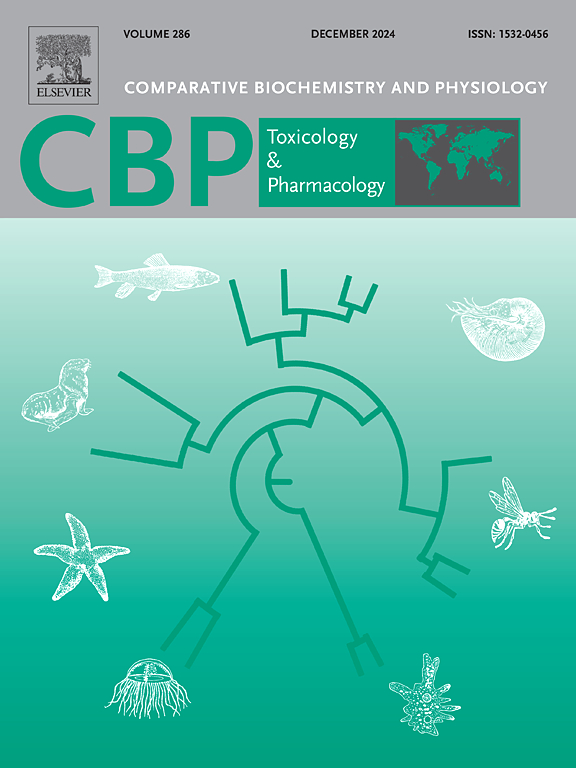巨噬细胞内颗粒物质的大小和化学性质与免疫毒性的关系
IF 3.9
3区 环境科学与生态学
Q2 BIOCHEMISTRY & MOLECULAR BIOLOGY
Comparative Biochemistry and Physiology C-toxicology & Pharmacology
Pub Date : 2025-05-01
DOI:10.1016/j.cbpc.2025.110215
引用次数: 0
摘要
近年来,空气污染已成为一个主要的公共卫生问题。温室气体的排放加剧了气候变化,从而影响了空气质量。在这些污染物中,颗粒物(PM)会造成呼吸和心血管损伤。颗粒物越小,进入人体的可能性就越大。然而,对PM免疫反应的研究是有限的,许多分子机制仍然未知。本文采用PM4 (<4 μm)和PM10 (<10 μm)两种粒径的颗粒物。结果表明,颗粒越小,吸附的元素越复杂。PM4引起更严重的细胞计数减少和外观变化。DMSO和PBS上清实验表明,PM的大小对细胞的影响更大。PM4表现出比PM10更大的毒性,这表明在24和48小时的细胞存活率较低。此外,PM4诱导更高水平的趋化性和活性氧(ROS)的产生,表明PM4具有更强的免疫激活反应。不同之处在于两种细胞的细胞周期阻滞处于不同的阶段,RAW264.7阻滞在Sub-G1期,而J774A阻滞在Sub-G1期。1在G2/M期阻滞,这可能是由于不同巨噬细胞菌株机制的差异或pm的复杂组成触发多种细胞机制所致。由于PM的化学成分,巨噬细胞也产生了趋化特性和ROS。结果表明,PM通过触发炎症、氧化应激和细胞周期阻滞来影响免疫系统,导致免疫功能障碍。本文章由计算机程序翻译,如有差异,请以英文原文为准。

The correlation of immunotoxicity with size and chemical properties of particulate matter within macrophages
In recent years, air pollution has become a major public health concern. The emission of greenhouse gases aggravates climate change, thereby affecting air quality. Among these pollutants, particulate matter (PM) can cause respiratory and cardiovascular damage. The smaller the particulate matter, the more likely it is to enter the body. However, research on immune responses to PM is limited and many molecular mechanisms remain unknown. Two sizes of particulate matter, PM4 (<4 μm) and PM10 (<10 μm), were used in this paper. The results showed that the smaller particles tend to adsorb more complex elements. PM4 caused more severe cell count reduction and appearance changes. Supernatant test with DMSO and PBS suggested a stronger effect of PM size on cells. PM4 exhibited greater toxicity than PM10, as indicated by lower cell survival rates at both 24 and 48 h. Additionally, PM4 induced higher level of chemotaxis and reactive oxygen species (ROS) production, suggesting a stronger immune activation response. The difference is that the cell cycle arrest of the two cells was at different phases, RAW264.7 arrest at the Sub-G1 phase and J774A.1 arrest at the G2/M phase, which might be due to the differences in the mechanisms of different macrophage strains or the complex composition of PMs triggering multiple cellular mechanisms. Macrophages also produced chemotactic properties and ROS due to the chemical composition of PM. The results indicate that PM affects the immune system by triggering inflammation, oxidative stress, and cell cycle arrest, leading to immune dysfunction.
求助全文
通过发布文献求助,成功后即可免费获取论文全文。
去求助
来源期刊
CiteScore
7.50
自引率
5.10%
发文量
206
审稿时长
30 days
期刊介绍:
Part C: Toxicology and Pharmacology. This journal is concerned with chemical and drug action at different levels of organization, biotransformation of xenobiotics, mechanisms of toxicity, including reactive oxygen species and carcinogenesis, endocrine disruptors, natural products chemistry, and signal transduction with a molecular approach to these fields.

 求助内容:
求助内容: 应助结果提醒方式:
应助结果提醒方式:


